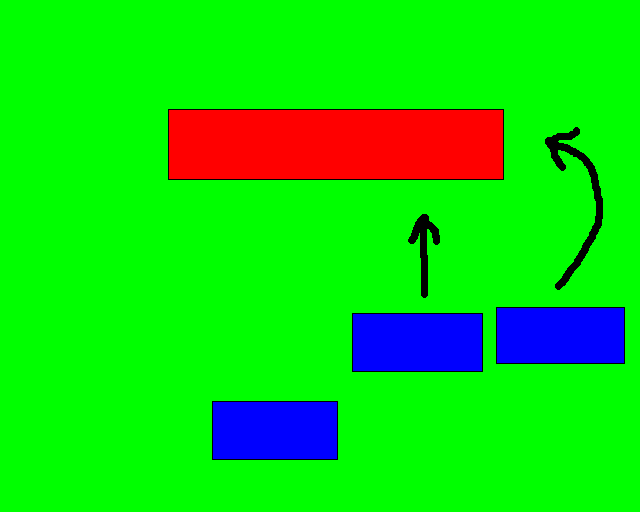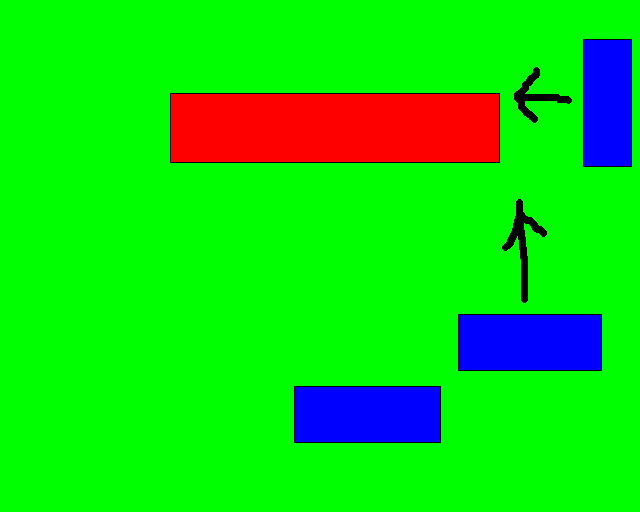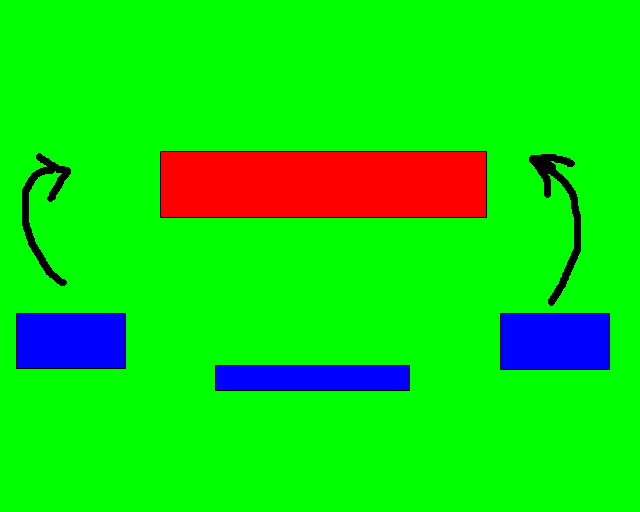
Basic battle plans
When the player organizes his troops in corps, he should have an idea of each corps goal and how coordinate them. It is an excellent idea to plan ahead the terrain and the possible attacks to execute.
Here is a list of the basic attack manouvers. Each army should be able to use at least one. The player should not be too rigid in their application, but is useful to have at least a solution thought ahead, for in the heat of the battle or the exhaustion of a tournament is easy to do something wrong. Keep the plan simple, and if in doubt stick to it.
Frontal attack

The basic attack. To execute it you need shock troops able to quick kill enemy, or have a superiority of CF, quality and/or number.
The attack should be supported by troops granting flank protection, to let the charging elements the time to smash opponents.
The more grinding is necessary to win, the more the reserves needed.
This is the basic plan for many irregular shock armies, as hairy foot or mounted barbarians, feudal Kn armies and also oriental Elephant based host
If planning to use this tactic, the terrain should not hamper your approach and your charge. So select well if possible the terrain, the attack sector and the target.
Oblique order

The oblique order is a variation of the frontal attack. It is executed with a wing corps, that must be the stronger. The center and the opposite wing follow in trail protecting a flank. The concept is to engage with your best troops and fighting for some turns before your weaker wing will be vcontacted by enemy.
The superiority of the attacking corps should weaken and hopefully break the enemy before he can start engaging the supporting troops. The player exploits time and momentum to create an ovewhelming and decisive superiority in the sector of choice
This kind of attack usually has the advantage of using the side edge or some bad going on a side as flank protection, avoiding to waste PIPs and troops to that role.
This plan needs a better coordination than the frontal attack, for the wing must push harder. A regular army is better suited than an irregular one to this tactic.
Swiss and Theban are historical example of armies using this attack. The more rigid is the opponent, the better is.
Flank attack

This attack is a change from the previous doctrines. Here what matters is not the brute strenght to smash through the enemy lines, but the speed, manouver and coordination to force the enemy to fight attacks coming from two directions.
This tactic works well with fast troops, as cavalry, on the manouvering wing. The central corps should fix the enemy, the outflanking wing disperse or force to withdraw enemy flank protection, then attack from side or rear the already engaged enemy.
The last corps has just a delay function. With this attack is possible to destroy a stronger opponent. Note that this tactic is more difficult to execute.
Flank Marching attack

This is a variation of the flank attack. It works well when terrain or the rigidity of your own army prevents a succesfully manouver on a flank.
The flank march enters directly in the enemy flank and rear sectors, and can be executed also by inept irregular troops.
The downside is that the entry is random, so is impossible coordinate it with the other corps. A flank march late entering sometime is a disaster for the army, so the player must assess if the risk is worth.
Double envelopment

This is the classical manouver used by Hannibal at Cannae. This tactic needs an edge in C3 and speed over the opponent. A brilliant general can help a lot.
Both the wings push hard on enemy flanks trying to enveloping and smashing them, while the center delay and try to hold the enemy.
Apart the coordination, speed is essential, for the weaker center risk to be destroyed. The wings must win quickly to prevent it.
Defensive Envelopment

This plan uses a delayed corps to execute the envelopment.
The advantage over flank marching is that delayed corps enter quite easily. The problem is that of coordination, for this plan, to be succesfull, needs an aggressive opponent that advances and exposes a flank.
This is a low risk plan by the way, because if opponent doesn't place itself in a dangerous position, the delayed corps can be used as reserve, to attack a quiet sector or as conditions suggest.